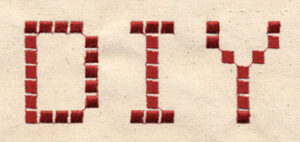
January 12, 2006
D.I.Y.: Design it Yourself

Embroidery by Zvezdana Rogic.
Design is, more than ever, a way to relate to the world around us. Our fascination with design, as both a process and an ideal, is reflected in the products and services that are increasingly available to the general public. We can customize nearly all the things we consume, turning mass-produced stuff into OUR stuff. We can custom-build cars online, download cellphone ringtones, and willingly pay a premium for uniquely-distressed jeans and one-of-a-kind courier bags. Buying has never been more ubiquitous — or arguably, more effortless — which may in truth speak more to the democratization of credit than the democratization of design.
And then there’s D.I.Y., or “Do It Yourself” — an approach perhaps best described as amateur undertakings, homespun experiments and abortive beginnings. D.I.Y. is the recipe you try; the spare room you wallpaper; my grandmother’s Christmas tree laden with her own hand-beaded ornaments, or the grossly-botched carpentry job my father proudly attempted one weekend — and paid for twice when my mother had to call in a licensed carpenter to repair it. D.I.Y. is a stab at something, and the finished do-it-yourself object is really the documentation of a working process. Most, if not all of the pleasure in D.I.Y. comes from the ‘doing’ part. Naturally, experts are exempt from such classification — we don’t, for instance, refer to a handcrafted chair or hospital appendectomy as D.I.Y. projects. We call them furniture and surgery.
D.I.Y.: Design it Yourself (Princeton Architectural Press, 2006) is also a new book edited by Ellen Lupton, written and designed by graduate students and faculty from the Graphic Design MFA program at MICA (Maryland Institute College of Art). Written primer-style, it aims to reach out to the non- or just-emerging designer: “This is a book for people from all walks of life who want to publish words, images, and ideas on paper, on t-shirts, on the Web, or anywhere else,” writes Lupton. (Her twin sister, Julia Lupton, also has an essay in the book.) Broken up into 32 brief chapters, many as short as four pages, the book condenses its content into sub-genres such as packaging, logos, and weblogs. Yet, in spite of such professional classifications, the most visually fresh and interesting projects aren’t the ones dealing with traditional forms of design (newsletters and business cards) but those that reside in a craftier realm: blank books, embroidery, or T-shirts.
Julia Lupton’s essay, ‘D.I.Y. Theory’ highlights the importance of doing by referencing Karl Marx: “Capital works by separating ownership from labor,” she explains. “The capitalist owns the means of production and distribution (the factory, the tools, the retail stores), while the worker does the producing (earning a wage instead of owning what he or she makes).” This statement might also describe the life of a “typical” employed designer: put another way, if you can’t own what you make, at least you can own the experience and the completely individual way you approach your work. (At the end of the day, this is your style or craft.) Arguably, it’s when you focus on HOW rather than WHAT you make that you begin to build a body of work — what Lorraine Wild describes as the “designer’s voice,” or “that part of a design that is not industriously addressing the ulterior motives of a project, but instead follows the inner agenda of the designer’s craft. This guides the ‘body of work’ of a designer over and beyond the particular goal of each project.”
Perhaps it’s precisely the absence of a cohesive body of work, in this book, that is most vexing — for while the brevity of the chapters allows the book to cover a lot of ground, the overall read is choppy, and the work shown here is uneven. Some chapters seem to end abruptly, while others feature a wider variety of projects. It is difficult to discern whether the authors intended to represent each student’s best efforts, or if certain pieces aren’t simply meant as sketches, illustrating an idea rather than a finished portfolio piece. From chapter to chapter, the work goes from looking like it was produced by undergraduates to looking like it was pulled from a late twentieth-century design annual, to finally — but not often enough for a book that’s the product of MFA candidates — to examples that reflect a sophisticated and highly individualized point of view. The result makes for a confusing visual read, one that is so overtly ‘designerly’ that the book seems an unlikely target for the non-designer. It’s neither simple and rigorous enough to truly appeal to the novice, nor beautiful enough to be an “annual” even though the work is highly fetishized. (The chapter on brands, for example, stands out for its cohesiveness in part, because its lesson is centered around a single project with similar, yet consistently well-crafted examples of one student’s line of customized baby clothes.)
Like the shifting quality of the work, there’s also an unevenness to the writing. And here, the duality is bizarre: from an almost teen magazine kind of language in the project chapters (characterized by a didactic “how-to” tone that could just as easily be instructing the reader on how to catch a guy or make an oatmeal mask), to the Luptons’ academic and somewhat radical essays referencing barbarians and shout-outs to Karl Marx. At the same time, the authors acknowledge that design in general (and graphic design in particular) can be identified as a “thing-by-itself” and perhaps has to be in order to be examined, understood and taught. Ellen Lupton explains: “As a medium closely connected to popular culture, graphic design has had a tough time defining itself as an autonomous academic discourse. One could say that for graphic design, the barbarians have always been at the gate. We are the barbarians, the bastard children of the fine arts. We are the publicists and popularizers, the people of the street.” While Lupton isn’t the first to address design and its core competencies at a nonprofessional level (in Design for the Real World, Victor Papanek wrote: “All men are designers. All that we do, almost all the time, is design, for design is basic to all human activity”), she may be the first to liken designers to barbarians. I suspect most practicing designers, on any given day, aren’t so sure which side of the gate they’re on. At best, we’re all out there doing our own thing, making it up as we go along, re-appropriating, re-purposing and reconsidering the options as we do so.
Which brings us back to D.I.Y., which is increasingly informing — and informed by — the cultural imperatives of a shifting economy. With manufacturing (our country’s long-standing economic mainstay) being moved overseas, we have become a service-based economy: everything we used to do ourselves can now be done for us, at a price. Merchandising, magazines and reality television have helped to elevate D.I.Y. to a spiritual high: today, you can remake a home, a wardrobe, or even a loved one, and you can do it yourself — so why not design things yourself? Here, design potentially takes on a much more significant role.
9/11 was a brutal D.I.Y. event, ratcheting our individual doing power up to an unprecedented level and making everyone seem a potential threat — or conversely, a potential hero. This event was all the more horrible because the attack was so lo-fi and unlikely: 20 men with box cutters, commercial airliners re-purposed as bombs? It would be nice to think that with the world in such a serious state, the role of design and designers might become one of greater consequence. Instead, we have a Homeland Security terror-alert system that advises us when to buy duct tape and plastic to cover up our windows. This is a placebo solution if ever there was one: the promise of D.I.Y. lulling us into the false belief that we have control over the things we fear the most.
In the end, D.I.Y.: Design It Yourself is perhaps most successful when it focuses on design examples that are borne of personal expression rather than professional need. Julia Lupton writes: “When you go public with a product or a message, you never know who is listening, or what they will make of it themselves.” In the spirit of such altruism, we would all do well to remember that while design may not always change the world, it can be instrumental in helping us make our way through it. And this is the side of the gate where designers should gather in the streets — with things to say rather than to sell.
Tracy Jenkins is a principal and founding partner in Village, a cooperative of type foundries based in New York City. She has worked at Ogilvy’s Brand Integration Group and 2×4 since completing her MFA thesis, ‘Do-it-Yourself’ at Yale University in 2004.
Observed
View all
Observed
By Tracy Jenkins
Recent Posts
Minefields and maternity leave: why I fight a system that shuts out women and caregivers Candace Parker & Michael C. Bush on Purpose, Leadership and Meeting the MomentCourtney L. McCluney, PhD|Essays
Rest as reparations: reimagining how we invest in Black women entrepreneurs Food branding without borders: chai, culture, and the politics of packaging



